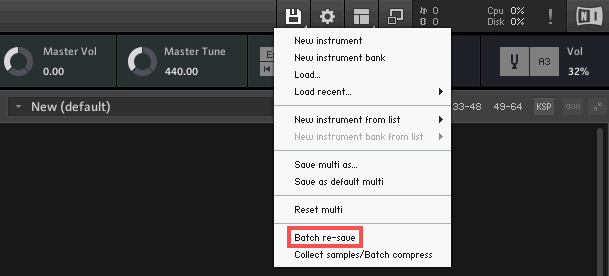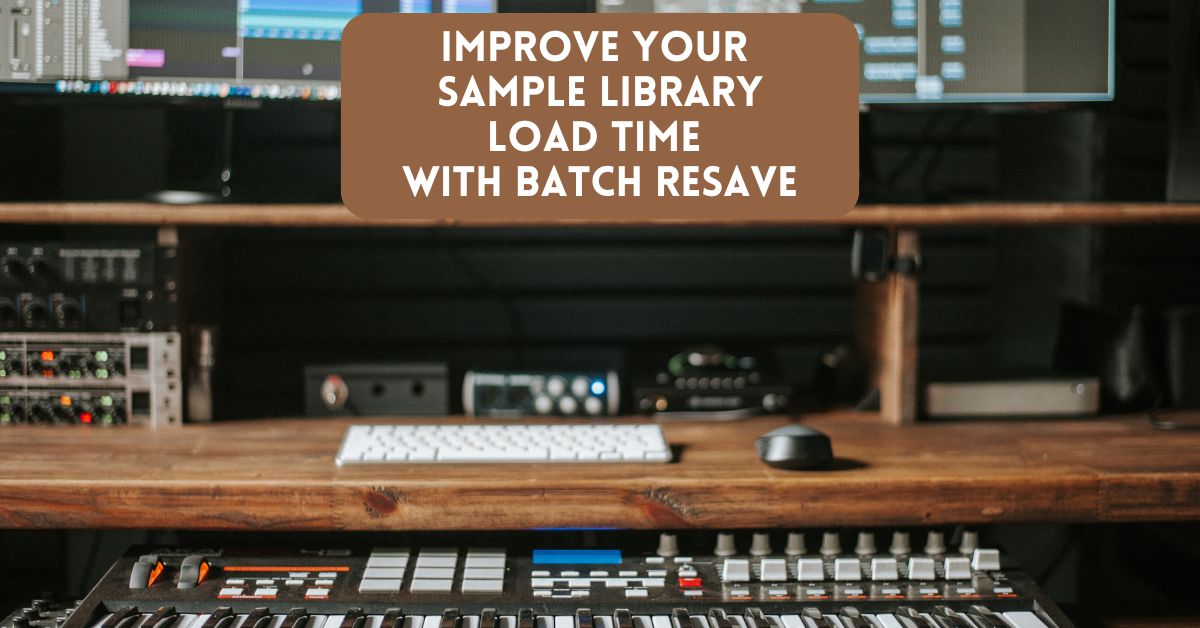In the fast-paced world of music production, efficiency is key. Waiting for sample libraries to load can be a major drag on your workflow, costing precious time and breaking your creative flow. Optimizing sample library loading times is crucial for any music producer, musician, or keyboard player looking to streamline their process and maximize productivity. In this article, we’ll explore how batch resave can significantly improve sample library loading times for more efficient music production.
Azure Hills Music contains affiliate links and is a member of the Amazon Services LLC Associates Program. As an Amazon Associate, we earn from qualifying purchases at no extra cost to you when you purchase using one of these Amazon links. Read our disclaimer and privacy policy for more information.
Slow Load Times With Sample Libraries
Loading sample libraries can be time-consuming, especially when purchased from a sound sample library company. I first experienced this problem after purchasing Albion libraries from Spitfire. Hoping to dive in and start making music, I was stunned at how long it took for a single patch to load. It was like going back to the days of dial-up internet through a phone line to access the internet. You might remember this frustration if you were around in the late 1980s when America Online was the rage.
Sample library companies often provide extensive collections of high-quality samples, making the initial loading process quite lengthy. On average, it can take several minutes for a single sample library patch to load if you haven’t optimized the library.
This is where the batch resave process comes to the rescue. This one process can significantly reduce future loading times. By batch resaving a sample library, all samples are converted to your DAW’s native format and stored more efficiently. This not only saves storage space but also speeds up the loading time of the samples. This way, when you’re ready to make music, your samples will be available to load quickly.
What is Batch Resave?
Batch Resave is a powerful feature in some music software, like Native Instruments Kontakt that allows you to resave all the samples in a library in a more efficient format. This process can significantly reduce loading times, making it easier to access the sounds you need when you need them.
Essentially, Batch Resave recalculates the locations of sample files, ensuring that they are correctly referenced and saved in a way that speeds up their retrieval.
Step-by-Step Guide to Using Batch Resave in Kontakt
- Open Kontakt: Launch the Kontakt application on your computer.
- Load the Library: Load the sample library you want to optimize. You’ll do this for one library at a time.
IMPORTANT: DO NOT try to process an entire folder with multiple libraries simultaneously!
- Access Batch Resave: Click on the “Files” menu in the top left corner and select “Batch Resave” from the dropdown menu. You may also see the Batch Resave option when selecting the “disc” icon.

- Confirm Directory: A window will pop up asking you to confirm the directory of the sample library. Make sure the correct library is selected.
- Start Resave Process: Click “OK” to start the process. Kontakt will go through each sample in the library and resave it in an optimized format. This may take some time, depending on the size of the library. I’ve had large libraries take many hours to go through this process, and I will often run it overnight while I’m sleeping. But you only need to do it once.
- Completion: Once the process is complete, your library is optimized for faster loading times.
Tips on Organizing and Prioritizing Sample Libraries
- Prioritize Frequently Used Libraries: Start by batch resaving libraries you use most often.
- Organize by Genre or Project: Group sample libraries by genre or project type to make them easier to find and use.
- Regular Maintenance: Periodically check and resave your libraries to ensure they remain optimized, especially after adding new samples.
Best Practices for Maintaining an Optimized Library
- Regular Updates: Keep your software and libraries updated to benefit from the latest optimizations and features.
- Backups: Always keep a backup of your original libraries before batch resaving in case something goes wrong.
- Consistent Naming Conventions: Use consistent naming conventions for your sample files and folders to avoid confusion and ensure smooth operation.
Sample Library Batch Resave Frequently Asked Questions FAQ
Does Batch Resave consume more hard drive space?
Batch resaving does not consume extra hard drive space. It basically opens the file, then resaves it. This refreshes the cache (NKC files) in Kontakt.
Sample Library Batch Resave YouTube Video
Check out my video for a visual overview of this process in Kontakt.
Spitfire Albion Blues – Solving Ridiculously Long Sample Library Load Times.
Conclusion
Speeding up loading times for your sample libraries can significantly enhance your music production efficiency. Using sample library Batch Resave, organizing your libraries, and following best practices fosters a smooth creative workflow. Give Batch Resave a try today and experience the difference it can make in your workflow!
Happy producing,
Arthur Dobrucki
Azure Hills Music
#batchresave


